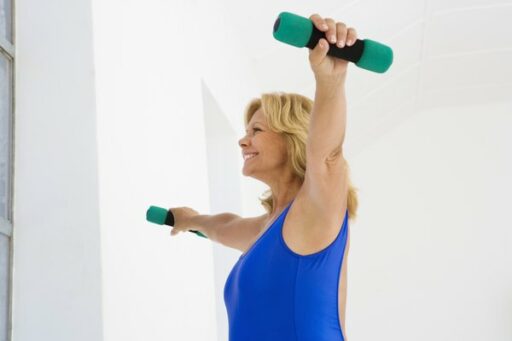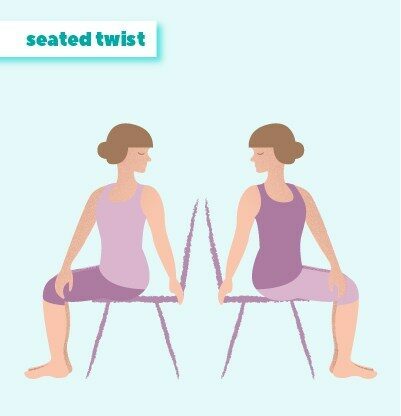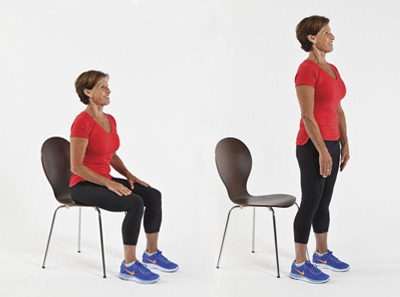Without a doubt, regular exercise is proper for you at any age. But if you’re entering into the golden years, At-Home Workouts for Seniors is even more critical, especially if you want to keep doing all the things you enjoy.
When it comes to exercising at home, having a game plan can help you stay motivated and on track to meet your fitness goals. If you’re working with a fitness trainer, physical therapist, or other exercise specialists, they will likely have a routine for you to follow.
But if you’re on your own, designing an exercise program that includes cardiovascular exercise, muscle strengthening, and balance training should give you a well-rounded fitness routine. This includes dancing, tai chi, low-impact sports, walking, weight lifting, and more.
Exercise Tips for Seniors

Take It Slow
Easing into an exercise program is the best way to stay safe and injury-free. Start with just your body weight and a comfortable range of motion, especially if you’re a beginner. Then, ensure your body is warm and genuinely ready for progression before picking up the pace or adding resistance.
Listen to Your Body
If you have an arthritic joint, an old injury that causes discomfort, or an ongoing condition, pay attention to times of the day when you feel your best and align exercise accordingly. Meal timing, medications, and weather can all be factors. Remember, exercising should never be painful or leave you overly sore.
Do a Pulse Assessment During Exercise
To stay safe at all times, check your pulse during exercise to ensure a safe heart rate, so you avoid overexertion. Most treadmills and bikes have heart-rate sensors you can use while working out. You can also use a heart-rate monitor or fitness watch with heart-rate readings.
Know Your Health Status
If you have any existing health conditions or you’re taking a medication that may affect physical activity. It’s essential to know and monitor the signs and symptoms associated with your situation. Take some time to review the symptoms that may indicate a heart problem or stroke that could arise during exercise, and make sure you speak to your doc before starting a new exercise routine.

Resistance Training for Seniors
When beginning a resistance training program, it’s good to start with exercises in a seated position and then progress to performing the activities while standing. To add resistance, use small hand weights or resistance bands.
Perform each exercise for the recommended repetitions. Then, move to the next exercise until you reach the end. Then, take a two-minute break and repeat once.
Move 1: Bicep Curl
- Grab 2- to 10-pound hand weights.
- Start with your arms by your sides, palms facing out.
- Curl the weights up to about chest height and hold for two seconds before releasing them.
- Do ten repetitions.
Move 2: Leg Extension
- Start with your feet flat on the floor.
- Extend your right knee and push your toes to the sky.
- Squeeze and hold for two seconds, lower, and switch sides.
- Do ten repetitions on each leg.
Move 3: Triceps Extension

- Grab 2- to 10-pound hand weights.
- Lean forward in your chair, keep your elbows close to the body.
- Extend your arms and squeeze the back of your upper arm (triceps) by holding for two seconds.
- Release and repeat.
- Do ten repetitions.
Move 4: Lateral Shoulder Raise
- Use 2- to 10-pound hand weights.
- With your elbows slightly bent, lift your arms out to the side until they parallel the floor.
- With palms facing the floor, hold for two seconds, then return to the starting position.
- Do ten repetitions.
Move 5: Toe Raise
- Keeping your heels on the ground, lift your toes to the sky and hold for two seconds.
- Release to starting position. You can alternate feet or do both at the same time.
- Do ten repetitions.
Stretching
This stretching sequence is an excellent add-on after a cardio workout, and if you plan on doing it as a stand-alone activity, warm-up (say, with some brisk walking) before moving into the stretches.

Move 1: Spine Rotation Stretch
- Sit upright with your shoulders back, and gently rotate your shoulders to the left.
- Come back to the center before gently rotating to the right.
Move 2: Kneeling Hip Flexor Stretch
- Kneel on the floor, or a blanket for more cushion, with one foot forward, flat on the floor. Gently sink, pushing your hips forward. You can hold a nearby chair for balance.
- Make sure to stretch both sides.
Move 3: Chest Stretch
- Find an unmovable object, like the wall or the edge of a door frame.
- Press onto the object with one arm, elbow bent at a 90-degree angle, hand raised.
- Gently turn your shoulders and body away from the working arm and hold for 20 seconds.
- Repeat on the other side.
Move 4: Calf Stretch
- Stand facing a wall.
- Hold onto the wall and move one foot back as far as you are comfortable with, making sure your toes face forward.
- Hold this stretch for 20 seconds and then switch sides.
Build strength, improve balance and maintain mobility
It’s essential to build muscle, improve balance, and maintain mobility at any age, but it’s especially critical for seniors. Therefore, integrating a simple, at-home routine is a great choice.

Move 1: Pass-Through (Balance/Mobility)
- Stand with your feet together and grasp a stretch rope, band or towel with a wide grip.
- With straight arms, pass the rope from your stomach over your head to your lower back.
- Slowly walk your hands closer together as mobility increases.
Move 2: Iron Cross (Strength/Mobility)
- Lie on your back and extend your legs to the ceiling with knees bent at 90 degrees.
- Stretch your arms wide at your sides, ensuring your shoulder blades, spine, and palms are all in contact with the floor.
- Slowly rotate your knees from side to side, keeping shoulder blades pinned to the floor to challenge your postural muscles.
Move 3: Hip Swing (Balance/Mobility)

- Lean against a wall with straight arms and extend one leg out in front of you.
- Swing your leg back and forth in front of your body laterally — like a golf swing with your leg.
Move 4: Wall Squat (Strength)
- With your back against a wall, slowly slide down as if you were going to sit in a chair.
- Find a challenging but holdable position for at least 20 seconds (a 90-degree angle at your hips and knees is the lowest you should go).
- Build up in time slowly.
Burn Calories
If you want to increase your heart rate, burn calories, and work on your lower body’s strength and flexibility, these workouts are for you. The foundation exercises help strengthen the muscles in and around the hips (including the lower back and abs). It can also serve as a warm-up.
Move 1: Bridge
- Lying on your back with knees bent, press your feet into the floor and lift hips off the floor and back to the floor.
- Do three sets of 15 reps.
Move 2: Leg Raise
- Remaining on your back with knees bent, lift your feet off the floor and return to the floor.
- Do three sets of 10 reps.
Move 3: Clamshell

- Lying on your side with hips and knees bent, lift your top knee while keeping your feet stacked on top of one another.
- Do three sets of 15 reps, flipping to the other side after each set.
Move 4: Back Extension
- Lying flat face down, rest your forehead on your hands.
- Lift the arms and head off the floor, making sure the forehead stays in contact with the hands. Be careful not to throw your head back as you lift off the floor.
- Return to the floor.
- Do three sets of 10 reps.
Move 5: Plank
- Lie face down with your forearms parallel on the floor, elbows under your shoulders.
- Come up to the forearms and feet while maintaining a straight line from head to heel. Be careful not to let your hips sag below your shoulders; squeeze your abdominal muscles to keep your hips and spine aligned.
- Hold for 30 seconds.
Cardio

You can repeat this cardio set two to three times. Make sure to rest for 60 seconds before moving to the next set. During the rest, consider working on stability. It would be best if you never missed an opportunity to improve balance, and the easiest way is with the stork stand (standing on one foot for up to 30 seconds).
Move 1: Marching
- March in place for 60 seconds.
Move 2: Modified Jumping Jack
- Instead of jumping laterally and back, step out and back while raising your arms over your head like a standard jumping jack.
- Do 20 repetitions.
Move 3: Get-Up
- Sitting on a couch or chair, feet slightly wider than your hips, stand up, then return to the seated position.
- Try to stand up without using your hands and arms.
- Do 15 repetitions.
I hope you found this article helpful and informative. If you have anything you’d like to share or any opinions about my website, please speak up. I look forward to your comments, questions, and the sharing of ideas.
Disclaimer: I am not a personal trainer or a healthcare professional. The workouts I post about work best for me and might not be the correct type of exercise for you. I always recommend consulting a doctor or health professional before making changes to your diet and fitness routine.
Related articles
Lifting Light vs Heavy Weight | Is one better than the other?
This will be a plus for my dad and my mom. Great tips about getting started and honestly, I never knew all of these exercises would be excellent for seniors. This post is also at the right time, especially the fact that it is during the lockdown. Thanks so much for sharing
This article is helpful for most seniors and people who have limited mobility or range of motion. When your body is not getting any exercise, you will lose strength and muscle mass. The whole point of the exercise is to keep moving. This is why I like this quote, “If you don’t use it, you’ll lose it.” This is so true. If you go to a nursing home, one of their leading practices for people who are bed-bound is to help them move their limbs with some sort of exercise as much as possible. Exercise helps your ligaments and muscles be flexible and strong. Another critically important part of exercising is having resistance exercises for seniors, including everyone. This can help boost brain size and help them improve their cognitive thinking. You did great in this article.
Hello John,
Thanks for sharing your thoughts.
All the best!